After chitting (in the garage) the first tubers were planted on 21st March. These were the First Early varieties, two each of "Sharpe's Express", "Marilyn", "Leontine" and "Red Duke of York".
Almost exactly 11 weeks later, on 6th June, the first ones were harvested. They were Sharpe's Express.
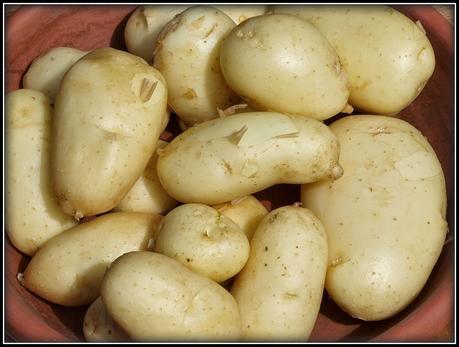
Sharpe's Express
I found them to be a classic new potato - light and almost creamy. They were very delicate, with papery thin skins that could be rubbed off easily, and needing only very brief cooking.
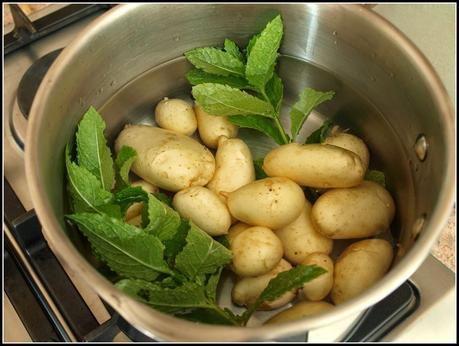
Sharpe's Express
The other First Earlies followed at a good even rate. Next to be harvested was Leontine:
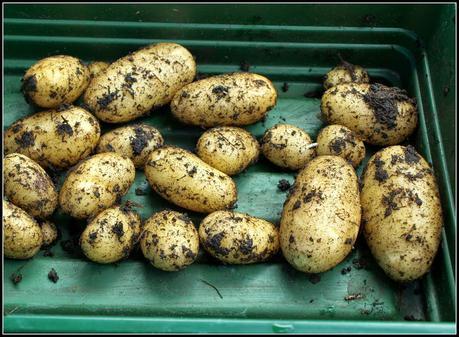
Leontine
Leontine was a good one for the kitchen. Their exceptionally smooth firm flesh cooked well with no disintegration. It would be a good one for using cold in salads.
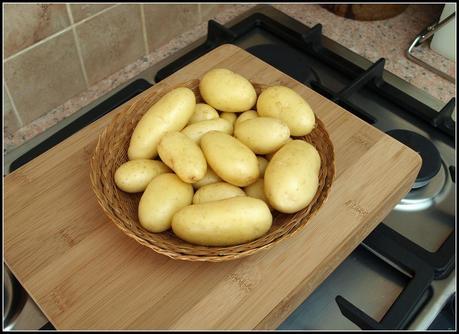
Leontine
There's no mistaking Red Duke of York, a very dramatic-looking potato:
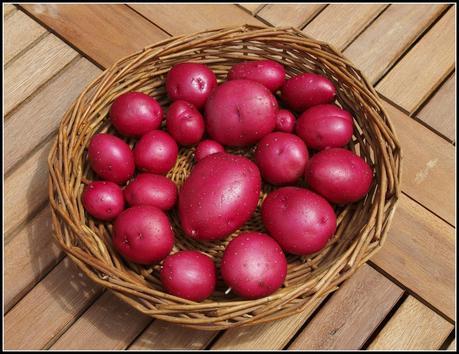
Red Duke of York
Whilst there is no doubt about its visual appeal, this variety produced a fairly small yield, and was difficult to cook. I found that it disintegrated easily, and the texture was too floury for a new potato.
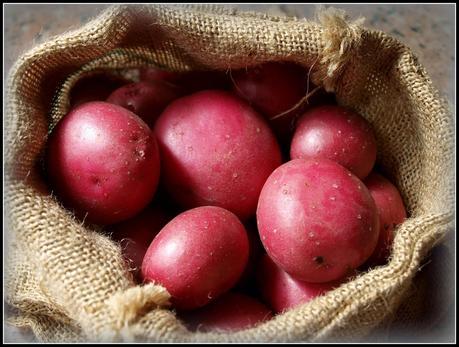
Red Duke of York
The last of my First Early varieties was Marilyn - apparently a variety that is very popular with the supermarkets (I'm instantly suspicious....) on account of its dependability and even appearance. Yes, this variety did produce very regular, even-sized tubers. A good variety in the kitchen too. It held up well when boiled.
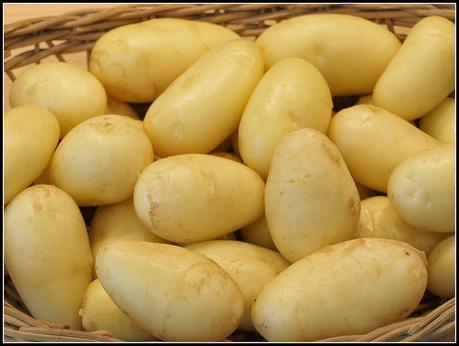
Marilyn
My Second Earlies were planted on 4th April - two each of "Balmoral" and "Blue Kestrel", and four of "Charlotte". I know Charlotte well, having grown it several times before, and I consider it to be perhaps the best potato variety of all. This is why I had more tubers of it than the others.
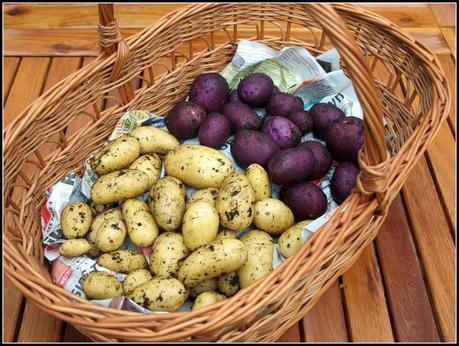
Charlotte and Blue Kestrel
Charlotte was as good as ever, and yielded well, but the Blue Kestrel is not one I will grow again. They look impressive (though the color of their skin colour fades to a dirty gray when cooked), but their taste and texture is less so.
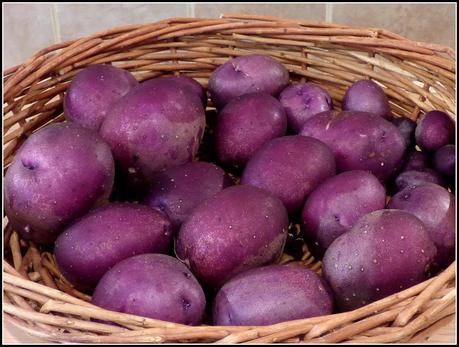
Blue Kestel
Charlotte is confirmed as the queen of new potatoes though - excellent in all respects.
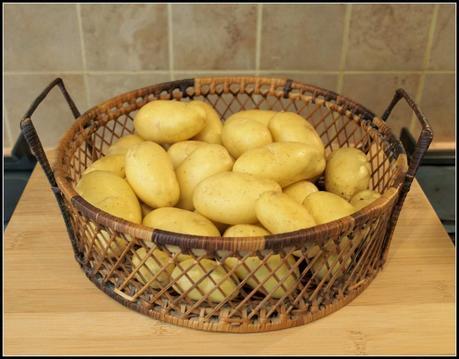
Charlotte
Balmoral was also a good-looker:
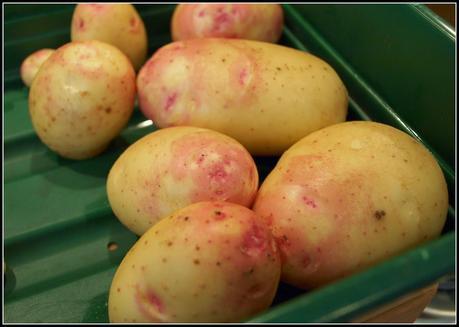
Balmoral
It produced the biggest tubers of all the varieties I grew this year, and also the smallest number. Despite their small numbers, they were good potatoes. We baked some of them and they were nice this way. If you are into growing for exhibition, I think this would be a good variety to choose.
The next variety to be harvested was "Harlequin", (planted 12th April) which is listed in the British Potato Variety Database as an early Maincrop. I have seen it described elsewhere as a Second Early, so I suppose it is an "Intermediate" one. It's parents are Charlotte and Pink Fir Apple, which I think is evident in its appearance - the kidney shape of Charlotte, with a tinge of pink color from PFA.

Harlequin
I thought this variety was OK, but (understandably) a bit of a compromise: not as good as either of its parents. The yield was modest too. I probably won't grow this one again.
My next one is "Nicola", which I had thought to be a Maincrop variety. I treated it as such, though I later realized it is a Second Early, not that that makes a lot of difference! Mine were planted on 18th April and harvested in late July and early August.
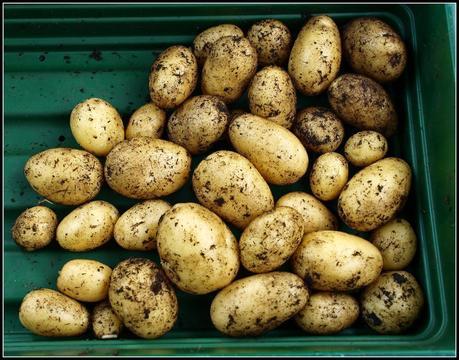
Nicola
The yield from Nicola was good, probably because (thinking them to be a Maincrop variety) I left them in the ground for longer than I needed to. The first pot of these yielded 35 useable tubers, weighing 900 grams - not bad from a single seed tuber! In terms of their culinary qualities, I think these are on a par with Charlotte.
My last variety - the only true Maincrop one - is "Pink Fir Apple". This is also one that I have grown many times. I usually avoid Maincrop varieties, because since they remain in the ground longer than the others they are more vulnerable to blight infection. I make an exception with PFA though, because the potential result is definitely worth the risk.
Mine were planted on 27th April, and the first pot was lifted on 24th August. In retrospect, this was possibly premature, because the yield was very small, a mere 281 grams:
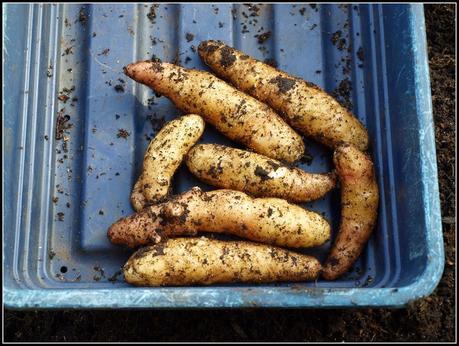
Pink Fir Apple
The next pot to be harvested yielded a more respectable 580 grams, which is about normal for this variety. I find that it concentrates more on quality than quantity!
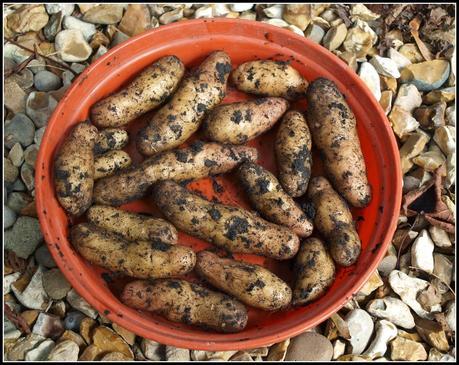
Pink Fir Apple
This year the risk paid off: blight finally arrived in my garden on 6th September, but by this time the potatoes had mostly been lifted. Only the last couple of pots of PFA remain, and their foliage is already brown and dry, so their tubers will have already matured.
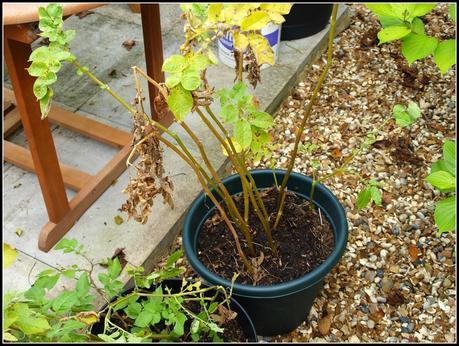
Pink Fir Apple plant ready for harvesting
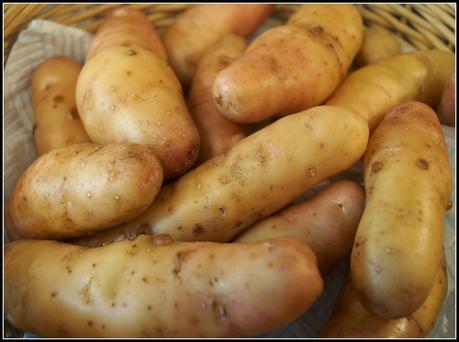
Pink Fir Apple
So what have my experiments with potatoes this year taught me?
Well, firstly they have confirmed that Charlotte and Pink Fir Apple are the ones for me, and Nicola will probably join them as a Regular. I liked Sharpe's Express a lot, and that will probably be my First Early of choice from now on. Balmoral may be lucky enough to feature again, but Red Duke of York and Blue Kestrel will definitely not. The others - Harlequin, Leontine, and Marilyn are ones I would happily grow again if someone gave me the tubers, but I would not seek them out because they are less good than my favourites.
An afterthought. Almost without exception my potatoes this year were smooth and practically unblemished. I put this down to the fact that they were grown in composted stable manure, with Multi-Purpose Compost being used only in the latter stages for earthing-up. The high level of organic matter obviously suited the potatoes well, probably because of its superior water-retention properties. Potatoes grown in pots can be difficult to hydrate properly and if their compost dries out it can promote the growth of the disease Scab. I shall definitely be using composted stable manure again next year.
